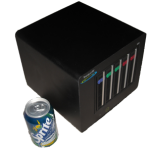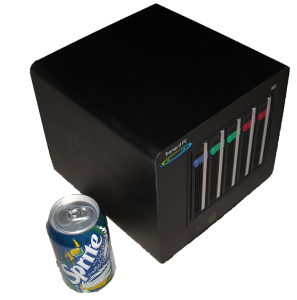So I had a bit of experimentation with the BBS2. I had purchased the storage drives (2x Samsung HD103UJ SpinPoint F 1TB Hard Drive) but had decided that I did not want the OS to be installed on the raid. So after scrounging a 160GB maxtor off a friend I installed Ubuntu Jaunty and successfully got the raid going, mounted and working. However, at the time Jaunty was only in beta, and there seemed to be some stability problems (which would be expected), over 48 hours I had 2 kernel panics that completely halted the system. I was not able to determine the cause.

Realising that I need this to be as stable as I can, I then opted for Ubuntu Hardy LTS, which has been around for a year now and would be much more stable, plus it’s supported with fixes for the next couple of years as well. Leaving the sever to run, I then noticed that the core temperature was getting a lot higher than expected, the Maxtor Diamond Max Plus 9, was running at near to 50 degrees and when the Samsung drives were moved adjacent to the Maxtor, their temperature went up to 42-45 degrees, this is within the operating temperature but I didn’t like the idea of them running at 10 degrees above their normal operating temperature.
So I purchased an old 8Gb Corsair Voyager GT from the same said friend, which has a 10 year replacement guarantee, stuffed it in a free USB port, installed Ubuntu Hardy to that and it works a treat. Bootup time is as fast if not faster than when installed on the Maxtor SATA drive, it’s plenty big enough for the OS, I mounted it with noatime, nodiratime, and the drives are sitting nicely at about 33 degrees c.
The BBS is acting as a print server, samba server for the wife’s Vista laptop, NFS server for me, has apache installed and exposed as http and https for providing my svn server (still to do). All the data is on the raid, which is currently defined as raid 5, but only has two drives and is therefore mirrored, but as my storage needs increase, I now have 3 free slots, bring the system to a maximum of 4Tb if needed (maintaining the current 1Tb drives). If I need more than that I can even purchase a second drive only box to get another 5 bays attached by eSata.
Some useful resources and tips when setting up the server
Setting up automatic updates in Ubuntu Hardy
Adding users, new users to groups and new groups
Creating self signed certificates for apache
Getting system temperature and sensors information:
- apt-get install lm-sensors, run sudo sensors-detect and answer yes to everything. Reboot, then run sensors to see all the info.
- apt-get install hddtemp don’t bother running as a daemon, run sudo hddtemp /dev/sd[e.g. a].
Easily enabling remote access for Cups:
- install lynx (the command line browser)
- run lynx localhost:631
- choose administration menu, then Basic Server Settings, Check Share published printers and allow remote administration. Change Settings and quit. Then in your nice gui browser goto machine name :631 and add printers, etc.
Install ebox it’s a great web admin interface, add the first line to /etc/apt/sources.list then run the second:
Install the ubuntu profiles for screen (screen allows you to start multiple bash sessions / run applications and they stay resident so you can re-attach to them in case of network dropout it’s cli based and can be run in an SSH connection), add the first line to /etc/apt/sources.list then run the second

